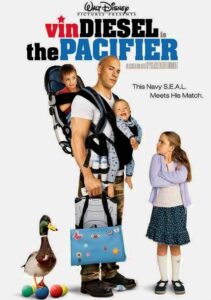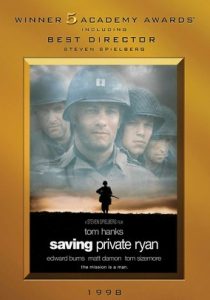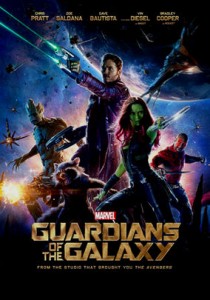The Pacifier-2005
Director Adam Shankman
Starring Vin Diesel, Lauren Graham
Scott’s Review #1,251
Reviewed May 1, 2022
Grade: C
The Pacifier (2005) is the kind of film that has been made for decades in one form or another. The setup is familiar and puts its macho movie star in situations that go against type or are deemed a bit feminine, and lightweight, all for the sake of a laugh.
As far back as the 1950s when Jack Lemmon and Tony Curtis donned lady’s clothing in Some Like it Hot (1959), to Michael Keaton in Mr. Mom (1983), to the 1990s when Arnold Schwarzenegger entertained audiences in Kindergarten Cop (1995), there is a pattern to follow.
And those are just decent films.
In 2005, the sexy Vin Diesel was one of the highest-grossing leading men in Hollywood churning out hits like Boiler Room (2000) and The Fast and the Furious (2001) to rabid audiences.
Known primarily for his action films, someone had the bright idea to domesticate the muscular star and put him in a situation where he would comically change baby diapers or vacuum a living room.
Unfortunately, The Pacifier is juvenile in nearly every way with canned gags and predictability for miles. Diesel is terrific to look at but isn’t the best actor in the world which causes the film to lose credibility.
Despite cliche after cliche and ridiculous situations, the film occasionally will elicit a chuckle or two from anyone brave enough to watch it.
That’s mostly because Diesel is willing to emerge in one scene covered in shit.
But don’t expect much more from The Pacifier.
Shane Wolfe (Diesel) is an elite Navy SEAL with muscles and charisma for miles. He is the type of man who would run into a fire and save a baby or swim out to sea to save a drowning child.
One day he makes a grave error in judgment when he fails to keep scientist Howard Plummer (Tate Donovan) safe from assassination and the man is killed.
Riddled with guilt, he is assigned to protect Plummer’s five children when the mother played by Faith Ford needs to leave the country temporarily. The kids include rebellious Zoe (Brittany Snow), Seth (Max Thieriot), and clingy Lulu (Morgan York).
The kid’s pet duck is along for the ride pushing the seasoned veteran to his breaking point.
Predictably, when Shane is not busy tending to the kids there is a secret project contained somewhere in the household that he must uncover.
Of course, a film like The Pacifier requires some romance so the inclusion of Principal Claire Fletcher (Lauren Graham) is for the sole purpose of having someone for Shane to fall in love with.
There is not great chemistry between Diesel and Graham so I wasn’t invested in them. The casting of the children is so one-dimensional with standard characteristics that it would be easy to laugh at.
I chose not to do this but rather strove to find something enjoyable in The Pacifier.
It’s a cute film but it’s so mainstream, dull, fluffy, and whatever generic adjective one would choose to describe it that it deserves the bland grade of C I am awarding it.
Diesel is the only appealing factor to The Pacifier.
Why make the bad guys as stereotypical as possible? They are North Korean and the ‘twist’ that Shane’s boss is in cahoots with them is as surprising as realizing the two-week-old Chinese leftovers in the fridge have gone bad.
The film has a small comparison to the superior The Sound of Music (1965) which the filmmakers must have realized since they incorporate it into the story. The kids that Shane is in charge of are behaving badly and attempting to play a practical joke on him.
In the end, there is a chase sequence, a reveal, peril, and a happy ending in more or less that order.
The Pacifier (2005) is a Disney film so there is a safe, family-friendly vibe throughout. It marginally entertains largely on the strength of Diesel.
He is sexy, and macho, and provides enough charisma to forget the bevy of standard gags and silly situations that he, and the audience, must endure.


